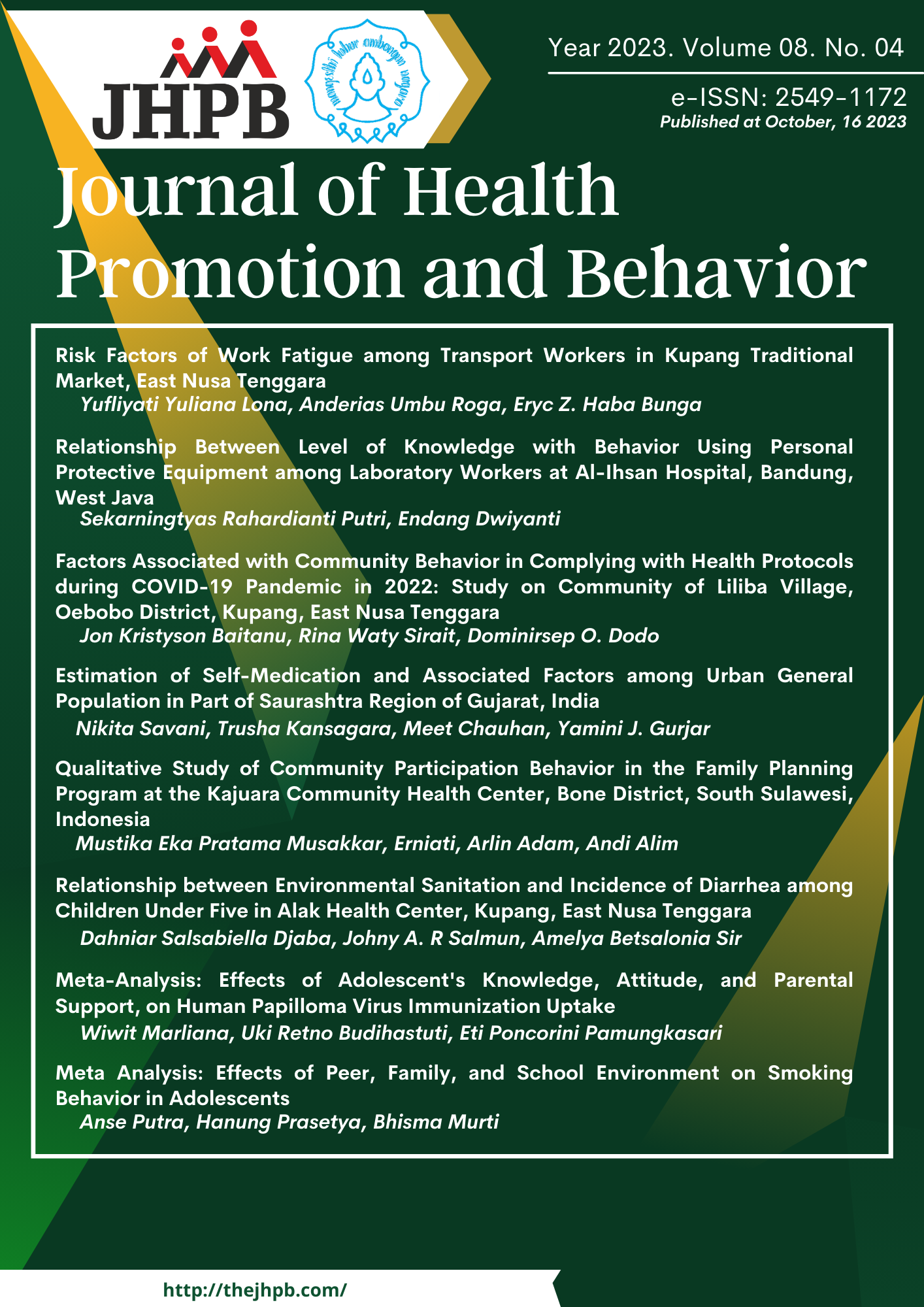Estimation of Self-Medication and Associated Factors among Urban General Population in Part of Saurashtra Region of Gujarat, India
DOI:
https://doi.org/10.26911/thejhpb.2023.08.04.04Abstract
Background: Self-medication is a universal phenomenon and is practiced globally with varied frequency. In several studies, it has been found that the potential disadvantage of self-medication is a waste of resources, increased resistance to pathogens, and causes serious health hazards such as adverse reactions and prolonged suffering. This study aimed to estimate the practice and factors associated with self-medication among the urban general population.
Subjects and Method: This community based cross-sectional study was conducted among general population of Amreli city, Gujarat, India from February to November 2022. A total of 110 subjects were include in this study. The dependent variable is self-medication practice. The independent variables are education, occupation, economic class. Data were collected by face-to-face interview using a semi-structured questionnaire with a recall period of 6 months’ experiences in 110 houses. Statistical analysis was done using Jamovi software.
Results: Upper socio-economic class (OR= 1.74; 95% CI= 1.05 to 2.90; p= 0.031), highly educated (OR= 0.58; 95% CI= 0.41 to 0.83; p= 0.003) more likely to do self-medication than the lower socio-economic class and low education.
Conclusion: Upper socio-economic and high education improve self-medication.
Keywords: Self-medication, urban, reasons, adverse effects.
Correspondence:
Yamini J. Gurjar. Department of Community Medicine, Shantabaa Medical College & General hospital, Amreli, Suarashtra University, Gujarat, India-365601. Email: yjgurjar@gmail.com. Mobile: 9428625208
How to Cite
References
Abahussain E, Matowe LK, Nicholls PJ (2005). Self-reported medication uses among adolescents in Kuwait. Med Princ Pract, 14(3), 161–164. Doi: 10.-1159/000084633
Bennadi D (2014). Self-medication: A current challenge. J Basic Clin Physiol Pharmacol. 5(1), 19. Doi: 10.4103/0976-0105.128253
Fernando ADA, Bandara LMH, Bandara HMST, Pilapitiya S, De Silva A (2017). A descriptive study of self-medication practices among Sri Lankan national level athletes. BMC Research Notes, 10(1), 1–12. Doi: 10.1186/s13104-017-2579-8
Jember E, Feleke A, Debie A, Asrade G (2019). Self-medication practices and associated factors among households at Gondar town, Northwest Ethiopia: a cross-sectional study. BMC Research Notes, 12(1), 1–7. Doi: 10.1186/s13104-019-4195-2
Joshi MC, Shalini, A. S. (2011). A questionnaire-based study of self-medi-cation practices among young population. Res. J. Pharm., Biol. Chem. Sci., 2, 761–766.
Kajeguka DC, Moses EA (2017). Self-medication practices and predictors for self-medication with antibiotics and antimalarials among community in Mbeya city, Tanzania. Tanzan. J. Health Res., 19(4), 1–10. Doi: 10.-4314/thrb.v19i4.6
Kapadiya J, Sampath N, Chhabra KG, Chaudhary P (2022). Modified B. G. Prasad Classification for Socioeconomic Scale Updated-2022. Indian J. Public Health, 66(4), 530–531. Doi: 10.4103/ijph.ijph_628_22
Kassie AD, Bifftu BB, Mekonnen HS (2018). Self-medication practice and associated factors among adult household members in Meket district, Northeast Ethiopia, 2017. BMC Pharmacol. amp; toxicol. 19(1), 4–11 Doi: 10.1186/-s40360-018-0205-6
Kayalvizhi S, Senapathi R (2007). Evaluation of the Perception, attitude, and knowledge about Self-medication among business students in 3 select cities. Int. J. Entrepreneurship Innov., 1(3), 40–44.
Kumar V, Mangal A, Yadav G, Raut D, Singh S (2015). Prevalence and pattern of self-medication practices in an urban area of Delhi, Indian J. Med. Sci. 8(1), 16–20. Doi: 10.4103/0975-2870.148828
Limaye D, Limaye V, Fortwengel G, Krause G (2018). Self-medication practices in urban and rural areas of western India: a cross-sectional study. Int J Community Med Public Health, 5(7), 2672. Doi: 10.18203/2394-6040.ijcm-ph20182596
Okyay RA, Erdoğan A (2017). Self-medi-cation practices and rational drug use habits among university students: A cross-sectional study from Kahrama¬-nmaraş, Turkey. Peer J, 2017(11). Doi: 10.7717/peerj.3990
Pandya R, Jhaveri K, Vyas F, Patel V (2013). Prevalence, pattern, and perceptions of self-medication in medical students. Int J Basic Clin Pharmacol, 2(3), 1. Doi: 10.5455/2319-2003.ijbcp-20130608
Patel MM, Singh U, Sapre C, Salvi K, Shah A, Vasoya B, Patel M (2013). Self-Medication Practices Among College Students: a Cross Sectional Study in Gujarat. Indian J. Med. Res.3(03), 257–260.
Paudel S, Aryal B (2020). Exploration of self-medication practice in Pokhara Valley of Nepal. BMC Public Health, 20(1), 1–5. Doi: 10.1186/s12889-020-08860-w
Rashid M, Chhabra M, Kashyap A, Undela K, Gudi SK (2019). Prevalence and Predictors of Self-Medication Prac¬tices in India: A Systematic Literature Review and Meta-Analysis. Curr. Clin. Pharmacol. 15(2), 90–101. Doi: 10.2174/1574884714666191122103953
Selvaraj K, Ramalingam A (2014). Prevalence of self-medication practices and its associated factors in Urban Puducherry, India. Perspect Clin Res, 5(1), 32. Doi: 10.4103/2229-3485.-124569
Sajith M, Suresh SM, Roy NT, Pawar DA (2017). Self-Medication Practices Among Health Care Professional Students in a Tertiary Care Hospital, Pune. Open Public Health J. 10(1), 63–68. Doi: 10.2174/¬187494¬450171-0010063
Sharma R, Verma U, Sharma CL, Kapoor B (2005). Self-medication among urban population of Jammu city [3]. Indian J. Pharmacol. 37(1), 40–43. Doi: 10.-4103/0253-7613.13856
V P, Narayanan P, Guddattu V (2017). Self-Medication Practice Among Urban Slum Dwellers in Udupi Taluk, Karnataka, India. Int. J. Pharm. Pharm. 9(6), 19. Doi: 10.22159/ijpps.2017-v9i6.15950
Verma RK, Mohan L, Pandey M (2010). Evaluation of self-medication among professional students in North India: Proper statutory drug control must be implemented. Asian J. Pharm. Clin. Res. 3(1), 60–64.
World Health Organization (1998). The role of the pharmacist in self-care and self-medication. Report on the 4th WHO Consultative Group on the Role of the Pharmacist. WHO/DAP/98.13. WHO, Geneva, Switzerland.
World Health Organization (2000). Guidelines for the regulatory assessment of medicinal products for use in self-medication. Geneva. World Health Organization.




